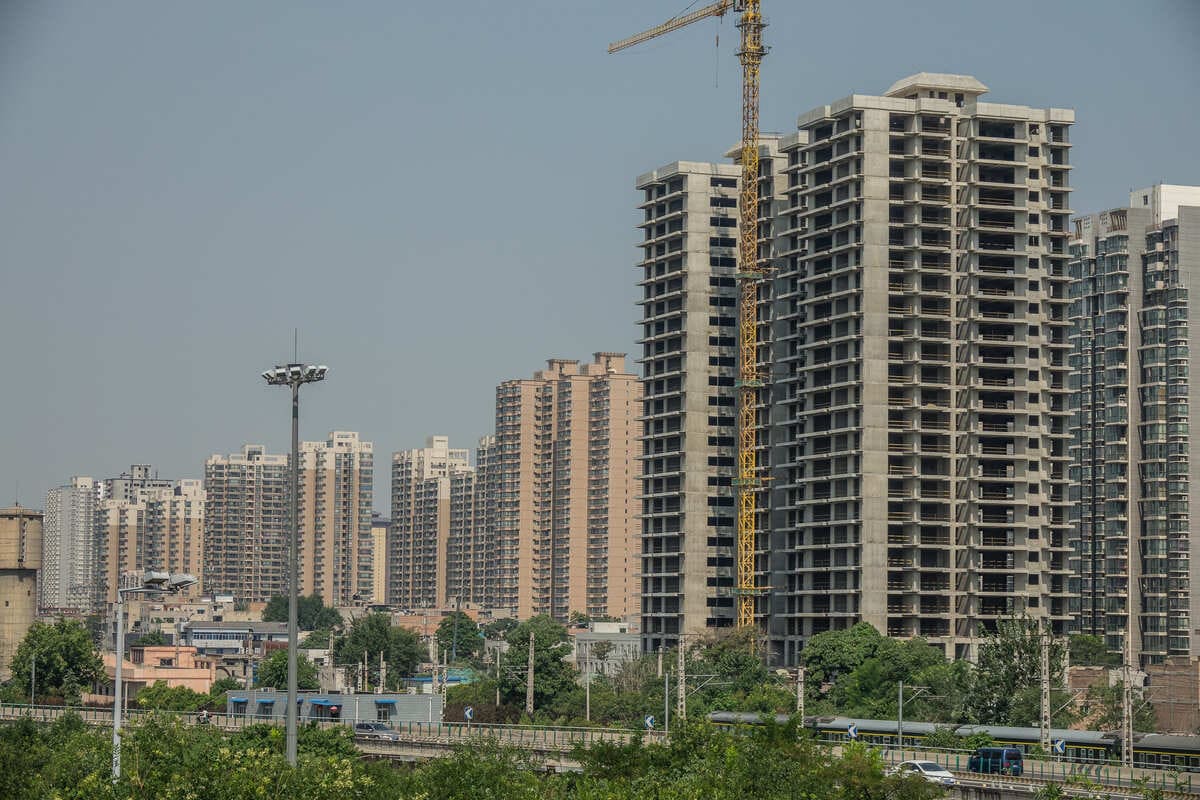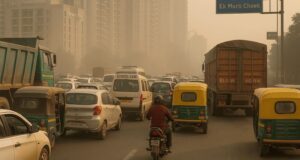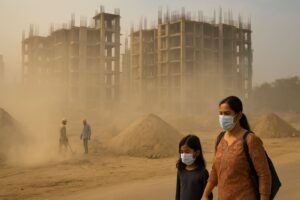
Greater Noida is known for its very poor air quality, regularly recording high pollution levels. The Air Quality Index (AQI) helps residents quickly understand how polluted the air is and how it affects their health.
AQI measures air pollution on a simple scale from 0 to 500. Lower numbers mean cleaner, safer air; higher numbers show unhealthy conditions. AQI is like a thermometer for air pollution—higher numbers mean the air has more harmful pollutants.
In Greater Noida, pollutants such as fine dust particles (PM2.5) and larger dust particles (PM10) cause most AQI issues. These tiny particles come from vehicle smoke, construction activities, factory emissions, and burning of fuels.
Breathing polluted air in Greater Noida regularly causes coughing, eye irritation, and breathing trouble, especially in children and older people. When AQI crosses 200, residents should stay indoors or use masks to avoid respiratory problems.
AQI is critical for Greater Noida residents and visitors to stay safe and healthy, especially since pollution here often ranks among the highest globally and is similar or sometimes worse compared to Delhi and other NCR cities.
What is Air Quality Index (AQI)?
Air Quality Index or AQI measures how clean or polluted the air is at any given time. Governments use AQI to clearly inform people about air pollution levels and potential health risks.
AQI in India is based on key air pollutants harmful to health:
- PM2.5: Very fine particles smaller than 2.5 microns, from vehicle smoke, factories, and burning waste.
- PM10: Larger dust particles (up to 10 microns), mostly from roads and construction.
- Nitrogen Dioxide (NO2): Mainly from vehicles, irritates lungs.
- Sulfur Dioxide (SO2): From coal burning factories, causes breathing trouble.
- Carbon Monoxide (CO): Comes from vehicle emissions, reduces oxygen supply.
- Ozone (O3): Created by chemical reactions in sunlight, affects breathing.
- Ammonia (NH3): Often from farming, irritates respiratory system.
- Lead: Rarely present but dangerous if inhaled.
Among these pollutants, PM2.5 and PM10 are usually highest in Greater Noida, causing major health issues like respiratory discomfort and lung problems.
AQI Scale and Health Effects
AQI is shown on a clear scale from 0 to 500, indicating different levels of health risk:
- 0–50 (Good): Air is safe, poses no health risks.
- 51–100 (Moderate): Generally safe, but people with breathing problems should take care.
- 101–200 (Unhealthy for Sensitive Groups): Risky for children, elderly, and anyone with respiratory issues; may cause mild breathing trouble.
- 201–300 (Poor): Unhealthy air for all; everyone might feel throat irritation, cough, or breathing difficulty.
- 301–400 (Very Poor): Serious health problems like severe coughing, wheezing, and irritation for everyone.
- 401–500 (Severe or Hazardous): Emergency situation; extremely harmful air that severely affects everyone’s health.
AQI often uses color-coded visual indicators to easily show pollution severity:
- Green: Safe
- Yellow: Moderate
- Orange: Unhealthy for sensitive groups
- Red: Poor, unhealthy
- Purple or Maroon: Severe, emergency conditions
Greater Noida AQI Month by Month
Air quality in Greater Noida changes significantly throughout the year. Knowing the monthly AQI patterns can help you stay safe and avoid exposure when pollution levels peak. Below is a clear, simple snapshot of monthly average AQI data for Greater Noida. Use this information to plan your outdoor activities and protect your family’s health.
| Month | Average AQI | AQI Category |
|---|---|---|
| January | 200-300 | Poor to Severe |
| February | 150-250 | Poor |
| March | 150-170 | Moderate to Poor |
| April | 150-200 | Moderate to Poor |
| May | 120-170 | Moderate |
| June | 100-150 | Moderate |
| July | 90-130 | Satisfactory to Moderate |
| August | 70-90 | Satisfactory |
| September | 90-120 | Moderate |
| October | 160-250 | Poor to Very Poor |
| November | 250-350 | Very Poor to Severe |
| December | 220-250 | Very Poor to Severe |
AQI in Greater Noida January
In January, Greater Noida AQI usually stays between 200 to 300, making it one of the most polluted months of the year. The cold winter air traps harmful pollutants close to the ground, creating a thick layer of pollution called temperature inversion. Due to this effect, dangerous particles (PM2.5) remain stuck in the lower air levels for many days.
During January, the city often looks foggy or smoky, causing low visibility. Cars, factories, smoke from wood fires used for heating, and pollution from New Year fireworks are the main reasons for this heavy smog. All these sources release tiny harmful particles that get trapped due to cold weather.
Breathing January polluted air can quickly lead to health problems like coughing, burning eyes, throat irritation, and difficulty breathing. Older people, children, and those with breathing issues suffer the most.
It is important in January to stay indoors as much as possible, especially during mornings and evenings. Use air purifiers inside your home, and always wear a pollution mask if you must go outside.
February AQI in Greater Noida
February AQI in Greater Noida mostly ranges between 150 and 250, showing a moderate improvement from January but still remaining unhealthy. Although pollution levels drop slightly, the air quality stays poor overall.
The main reason February air sees some improvement is warmer weather, weaker temperature inversion, and occasional windy days. This helps disperse PM2.5 and other lingering air pollutants from previous colder months. Early spring rains, although rare, sometimes clear the air further, giving a few AQI clear sky days.
Yet pollution stays clearly unhealthy because local sources continue polluting at full strength. Vehicle and industrial emissions in February keep releasing harmful particles into the air every day. As a result, breathing issues, coughing, and throat discomfort remain common, requiring clear respiratory caution throughout February.
Greater Noida AQI in March
Greater Noida AQI in March typically stays between 150 and 170, marking a clear improvement compared to winter. This month acts as a cleaner transition period, shifting air quality from severe winter conditions to a moderate category. Though not completely safe, March brings noticeable early spring AQI relief.
Pollution levels improve because warmer temperatures reduce the cold-weather effect that traps pollution. Increased wind speeds help with pollution dispersion, allowing harmful particles, especially PM2.5, to clear away faster. Occasional spring rain showers further lower the AQI by washing away lingering pollutants. As a result, residents see clearer skies, better visibility, and sometimes even a few AQI satisfactory days (below 100).
Despite this improvement, March air quality can still impact health, especially for sensitive groups who face mild respiratory irritation. Residents should continue precautions, such as wearing masks outdoors, using air purifiers indoors, and avoiding prolonged outdoor activities on days when pollution remains elevated.
April AQI in Greater Noida
Greater Noida AQI in April usually stays between 150 to 200, making air quality moderate overall. However, pollution levels can suddenly jump above 200 for short periods, particularly during dust storms. April air is unstable, shifting quickly from moderate to poor due to frequent April AQI variability.
Dust storms become common in April, raising PM10 levels sharply and creating gritty air conditions. Local factors like construction dust in Greater Noida further contribute to these sudden AQI spikes.
Meanwhile, warmer weather and stronger sunlight lead to increased formation of ground-level ozone, another pollutant noticeable during afternoons. Unlike winter months, PM2.5 pollution decreases in April because crop burning and heating-related wood fires stop.
April air still causes health issues, including throat irritation, sneezing, and allergy symptoms due to increased springtime pollen pollution and dust. Residents clearly need precautions: use pollution masks during dusty days, limit outdoor activities during peak pollution hours, and keep air purifiers running indoors to maintain healthier breathing conditions.
Greater Noida AQI May
Greater Noida AQI in May typically ranges from 120 to 170, which places it clearly within the moderate category. Higher temperatures in May help create strong air circulation, naturally lifting and dispersing pollutants upward, leading to improved air conditions.
Occasional pre-monsoon thunderstorms further clear pollutants temporarily, bringing brief relief and clearer skies.
Despite these improvements, hot, dry winds called loo winds regularly carry dust, significantly raising PM10 levels and causing gritty air conditions. Sporadic landfill fires nearby occasionally add smoke pollution.
Local traffic and industries also continue to release pollutants daily. Sensitive groups like children and those with breathing issues can still experience irritation or mild breathing discomfort.
Residents clearly need to remain cautious in May. Wearing masks on dusty days, avoiding outdoor activities during periods of increased pollution, and regularly using indoor air purifiers will help maintain safer breathing conditions throughout the month.
Greater Noida AQI in June
Greater Noida AQI in June mostly stays between 100 and 150, making air quality clearly better than earlier months. Occasional rains by mid-to-late June significantly reduce pollutants like PM2.5, effectively washing them from the air.
This natural cleansing leads to clearer skies, less dust, and better visibility overall, marking a clear AQI transition period from summer towards monsoon.
Despite improved conditions, sunny days in June can briefly raise ozone levels, slightly affecting sensitive groups such as children and those with breathing issues. While air quality noticeably improves, residents must still take precautions.
Using pollution masks outdoors during sunny afternoons and continuing indoor air purification clearly help maintain healthy breathing conditions. June’s increasing humidity and regular showers bring important relief, yet caution remains necessary to protect against lingering pollutants during this transition month.
August AQI in Greater Noida
Greater Noida AQI August typically shows the lowest pollution levels, making it the best air quality month for Greater Noida. Average PM2.5 levels drop to just 47.1 μg/m3, clearly the lowest monthly reading each year. Active monsoon rains throughout August regularly remove pollutants from the air, preventing pollution buildup.
Frequent rains, constant cloud cover, and steady winds work together effectively, keeping harmful particles like PM2.5 and ground-level ozone very low. Residents clearly notice crisp air, blue skies, and lush greenery free of dust. These changes distinctly mark August as Greater Noida’s cleanest air period.
Due to improved air quality, respiratory issues clearly decrease in August. Residents find breathing easier, experiencing fewer coughs or throat irritations. It is generally safe to open windows for fresh air during rainfall; however, continuing to use indoor air purifiers during humid days ensures consistently healthy breathing conditions indoors.
Greater Noida AQI September
Greater Noida AQI in September is usually between 90 and 120, making air quality moderate. Early in the month, air stays cleaner because some rain from the monsoon continues. But towards late September, pollution levels clearly begin rising again.
By late September, the rain mostly stops and weather becomes dry again. Without rain and winds, dust and pollution particles (PM2.5) build up easily. Sometimes in early morning, you might see mist forming close to the ground. This mist can trap dust and pollution, making the air hazy. It shows clearly that pollution season is coming back.
During this time, people may start feeling breathing problems again, like coughing or throat irritation. To stay safe, clearly remember to get your air purifier checked, keep extra masks ready, and try to spend less time outdoors during hazy mornings and evenings. This clearly helps you prepare for increasing pollution as October gets closer.
October AQI in Greater Noida
Greater Noida AQI in October typically ranges between 150 to 250, with levels often rising above 300 late in the month. October clearly marks the start of the pollution season, ending the cleaner months.
Pollution increases sharply in October because rains stop completely, making the air dry. Farmers nearby start burning crop stubble, sending smoke and harmful particles (PM2.5) into Greater Noida’s air. Cooler nights also trap pollution close to the ground.
If Diwali happens in October, firecrackers push pollution levels even higher. You can clearly see the sky becoming hazy, visibility dropping, and sometimes smell smoke outdoors, especially in evenings.
This increased pollution clearly causes health issues like coughing, throat problems, and breathing trouble. People must clearly limit outdoor activities, especially early mornings and evenings. Always use masks outdoors, run air purifiers indoors, and keep checking AQI updates daily. These steps clearly help you stay safe as pollution rises in October.
November Air Quality in Greater Noida
Greater Noida AQI November usually reaches 250 to 350, clearly making it the worst air quality month of the year. Air pollution becomes hazardous, causing serious health risks.
November pollution is highest because farmers in nearby Punjab and Haryana burn crop stubble. This sends heavy smoke and harmful particles (particulate matter PM2.5 November) directly into Greater Noida’s air. Cooler weather creates a temperature inversion trapping pollution near the ground.
Winds become weak, making pollution build up quickly. During Diwali, firecracker pollution spikes make things worse, filling the sky with thick, orange-grey smog and making breathing difficult.
Health problems clearly rise in November, with more people suffering from coughing, sore throats, breathing trouble, and eye irritation (respiratory illness increase November). Authorities often announce AQI emergency measures November, advising people to stay inside. To stay safe, residents must clearly limit outdoor activities, always wear pollution masks outside, keep air purifiers running at home, and check AQI updates daily.
December AQI in Greater Noida
Greater Noida AQI December usually stays around 220 to 250, clearly still very polluted but slightly better than November. Pollution remains severe due to cold, calm weather trapping harmful particles near the ground.
The main reasons pollution stays high are temperature inversion, low winds, and ongoing vehicle emission peak December. Some smoke from leftover residual crop burning pollution remains in the air. Late December also sees brief AQI spikes from holiday fireworks, adding more particulate matter PM2.5 December. The sky often looks grey, with thick smog buildup December making visibility low.
People in Greater Noida clearly face increased respiratory illness December, including cough, throat irritation, and breathing trouble. Clear precautions must include staying indoors as much as possible, using pollution masks outdoors, running indoor air purifiers, and regularly checking AQI updates.
Why Greater Noida Has Poor Air Quality
Greater Noida has very poor air quality with average PM2.5 pollution levels about 89.5 to 106 μg/m³. This pollution level clearly exceeds the safe limit set by the World Health Organization, which is only 5 μg/m³. Greater Noida ranks as the 6th most polluted city in India and the 7th most polluted city worldwide, clearly highlighting how severe the air pollution problem is.
Major sources of this pollution include heavy vehicle traffic, construction dust, factory smoke, and nearby farmers burning crop stubble. Stagnant weather and cold air also trap pollution close to the ground. Daily AQI levels are usually “poor” or “very poor,” commonly crossing 200. Days with good air quality (AQI below 50) are very rare and usually happen only during monsoon rains.
Berkeley Earth analysis compares breathing Greater Noida air daily to smoking around 1.3 cigarettes each day. Residents often experience coughing, breathing difficulty, and throat problems, clearly impacting their daily lives and health.
Major Sources of Air Pollution in Greater Noida
Greater Noida struggles with poor air quality all year, often ranking among the world’s most polluted cities. Understanding exactly why the air stays polluted is important to clearly protect your health. Here are the main reasons for Greater Noida’s severe air pollution:
- Vehicle Pollution : Vehicles such as cars, buses, trucks, and scooters release harmful particles (PM2.5) into the air. Heavy traffic jams and older vehicles make pollution worse each day.
- Industry and Factories: Factories and power plants around Greater Noida regularly produce smoke and dangerous gases. Industrial emissions clearly make the air unhealthy, affecting daily AQI levels.
- Construction Dust: Constant building projects and road work kick up lots of dust (PM10), which stays in the air and makes breathing difficult.
- Crop Burning in Nearby States: Farmers in nearby Punjab and Haryana burn leftover crops, sending thick smoke to Greater Noida. This clearly increases pollution sharply each October and November.
- Fireworks during Festivals: Festival fireworks, especially during Diwali, clearly add harmful smoke, making air quality suddenly worse and visibility poor.
- Weather and Geography: Cold winter air traps pollutants near the ground (temperature inversion). Dust storms blowing from Rajasthan also briefly increase pollution levels.
- Pollution from Nearby Cities: Pollution from nearby cities like Delhi, Noida, and Ghaziabad travels into Greater Noida, clearly worsening local air quality.
Impact of Air Pollution on Health and Daily Life
Air pollution in Greater Noida clearly affects people’s health every day. High AQI levels, especially PM2.5, cause serious problems. Here are the main health and daily life impacts:
- Coughing and breathing trouble
- Sore throat and itchy eyes
- Higher asthma risk for kids
- Heart problems and lung damage
- Frequent tiredness and headaches
- Anxiety from polluted grey skies
- Itchy skin and eye irritation
- Outdoor activities clearly reduced
To stay safe from pollution, residents should always wear masks outdoors, use air purifiers indoors, and avoid outdoor time during very polluted days. Regularly checking AQI updates clearly helps residents make healthier choices daily.
Tips for Protecting Yourself from Air Pollution
Greater Noida pollution can clearly harm your health. To protect yourself, follow these easy daily steps:
- Check AQI daily with trusted apps
- Wear N95 masks when outside
- Use air purifiers inside your home
- Open windows only after rainfall
- Keep indoor plants for cleaner air
- Eat fruits to boost immunity
- Drink water regularly to ease breathing
- Avoid busy roads with heavy traffic
- Replace car air filters often
- Limit outdoor play on polluted days
Taking these steps helps protect you and your family’s health from air pollution. Remember these simple points daily to breathe safer air.
Frequently Asked Questions
Which month has the worst air quality in Greater Noida?
November clearly has the worst air quality in Greater Noida, with AQI often reaching severe levels around 250–350. Main reasons include crop stubble burning, Diwali firecracker smoke, and cold weather trapping pollutants (PM2.5) close to the ground, causing serious breathing issues and health problems.
Which month has the best air quality in Greater Noida?
August clearly has the best air quality in Greater Noida, with average AQI around 80–90, the lowest all year. Continuous monsoon rains remove pollutants like PM2.5, significantly cleaning the air. Residents experience clearer skies and easier breathing during this month.
How does Greater Noida AQI compare to Delhi?
Greater Noida’s AQI is mostly like Delhi’s, usually very polluted. Both cities face similar problems from vehicle smoke, factories, and crop burning. On some days, Greater Noida air can be slightly better or worse, depending on wind and nearby pollution sources.
Why does air quality become very poor in winter in Greater Noida?
Greater Noida air becomes very polluted in winter mainly because of crop burning, firecrackers during festivals, and cold weather trapping smoke near the ground. Weak winds and cold air hold pollution (PM2.5) close, making air quality severely bad and harmful for breathing.
Has Greater Noida air quality improved recently?
Greater Noida air quality has slightly improved recently, but pollution still remains high. After 2020, pollution dropped a little due to cleaner vehicles, fewer crop fires, and better pollution controls. Still, AQI often stays unhealthy, and more improvement is clearly needed.
What are the main pollutants in Greater Noida air?
Main pollutants in Greater Noida are PM2.5 (fine dust from vehicles, factories, and crop fires), PM10 (dust from roads and construction), smoke from diesel engines, and gases like nitrogen dioxide (NO2) and sulfur dioxide (SO2). These pollutants clearly harm lungs and breathing.
What can I do personally to reduce air pollution in Greater Noida?
You can clearly help reduce pollution by using public transport, carpooling, planting trees, and not burning garbage. Keep your vehicle serviced, avoid diesel cars, use clean energy at home, and save electricity. These simple actions clearly help lower pollution and keep Greater Noida air cleaner.

 Greater Noida
Greater Noida

